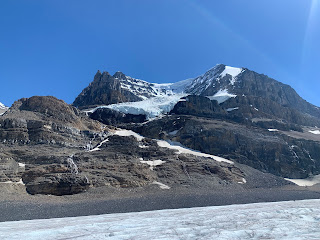This post is more than a year late, because National Geographic was going to do a story on it, but they just cancelled it ...
We were invited to go up to the Ruth Glacier near Denali to do some ice thickness measurements. This place if of interest, because it is suspected to be one of the deepest gorges in North America. The glacier is flanked by Mt. Dickey on one side and Mooses Tooth on the other side, both of which rise over 1500 m (5000 ft) above the glacier surface. Because so much ice is funneled through this gorge it was also suspected to be quite deep and there is a report from seismic measurements that claims that the ice is over 1000 m deep.
The area is often visited by climbers. It was also of great interest to Brad Washburn, as, for example, shown in the recent movie 'The Sanctity of Space'.
Here is a look up the gorge, with Mt. Dickey on the left:
The upper glacier (the Amphitheater) contains a large nunatak where the famous Talkeetna pilot built a mountain hut for use by climbers and skiers, or people who just want to spend some time in an amazing setting.

This nunatak became a private inholding in Denali National Park which allowed the younger Sheldon to build a luxury lodge in an unbelievable setting. We were invited to use this lodge as a 'base camp' for a week, from where we went out to survey the glacier.

A sunrise photo of the majestic Denali towering more than 4000 m above us:
Our goal was to measure ice thickness, which we did with a specially designed low frequency radar. This was quite successful in the amphitheater where we measured ice up to about 900 m (3000 ft) thick, but the Great Gorge alluded us, probably because of the deep and narrow geometry. However, we can be pretty certain that the depth is less than a 1000 m, simply on consideration of ice flow.
A particularly nice sun rise with a sun dog:
We had mixed weather, but on snowy days we got to see some amazing snow avalanches coming off the steep valley walls.















































